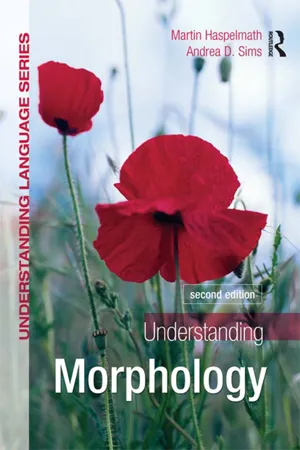![]()
Introduction1
1.1 What is morphology?
Morphology is the study of the internal structure of words.1 Somewhat paradoxically, morphology is both the oldest and one of the youngest subdisciplines of grammar. It is the oldest because, as far as we know, the first linguists were primarily morphologists. The earliest extant grammatical texts are well-structured lists of morphological forms of Sumerian words, some of which are shown in (1.1). They are attested on clay tablets from Ancient Mesopotamia and date from around 1600 BCE.
| (1.1) | badu | ‘he goes away’ | inen | ‘he went’ |
| baduun | ‘I go away’ | inenen | ‘I went’ |
| bašidu | ‘he goes away to him’ | inšien | ‘he went to him’ |
| bašiduun | ‘I go away to him’ | inšienen | ‘I went to him’ |
(Jacobsen 1974: 53–4)
Sumerian was the traditional literary language of Mesopotamia but, by the second millennium BCE, it was no longer spoken as a medium of everyday communication (having been replaced by the Semitic language Akkadian), so it needed to be recorded in grammatical texts. Morphology was also prominent in the writings of the greatest grammarian of Antiquity, the Indian Pāṇini (fifth century BCE), and in the Greek and Roman grammatical tradition. Until the nineteenth century, Western linguists often thought of grammar as consisting primarily of word structure, perhaps because the classical languages Greek and Latin had fairly rich morphological patterns that were difficult for speakers of the modern European languages.
This is also the reason why it was only in the second half of the nineteenth century that the term morphology was invented and became current. Earlier there was no need for a special term, because the term grammar mostly evoked word structure, i.e. morphology. The terms phonology (for sound structure) and syntax (for sentence structure) had existed for centuries when the term morphology was introduced. Thus, in this sense morphology is a young discipline.
Our initial definition of morphology, as the study of the internal structure of words, needs some qualification, because words have internal structure in two very different senses. On the one hand, they are made up of sequences of sounds (or gestures in sign language), i.e. they have internal phonological structure. Thus, the English word nuts consists of the four sounds (or, as we will say, phonological segments) [nΛts]. In general, phonological segments such as [n] or [t] cannot be assigned a specific meaning –they have a purely contrastive value (so that, for instance, nuts can be distinguished from cuts, guts, shuts, from nets, notes, nights, and so on).
But often formal variations in the shapes of words correlate systematically with semantic changes. For instance, the words nuts, nights, necks, backs, taps (and so on) share not only a phonological segment (the final [s]), but also a semantic component: they all refer to a multiplicity of entities from the same class. And, if the final [s] is lacking (nut, night, neck, back, tap), reference is made consistently to only one such entity. By contrast, the words blitz, box, lapse do not refer to a multiplicity of entities, and there are no semantically related words *blit, *bok, *lap.2 We will call words like nuts ‘(morphologically) complex words’.
In a morphological analysis, we would say that the final [s] of nuts expresses plural meaning when it occurs at the end of a noun. But the final [s] in lapse does not have any meaning, and lapse does not have morphological structure. Thus, morphological structure exists if there are groups of words that show identical partial resemblances in both form and meaning. Morphology can be defined as in Definition 1.
Definition 1:
Morphology is the study of systematic covariation in the form and meaning of words.
It is important that this form–meaning covariation occurs systematically in groups of words. When there are just two words with partial form–meaning resemblances, these may be merely accidental. Thus, one would not say that the word hear is morphologically structured and related to ear. Conceivably, h could mean ‘use’, so h-ear would be ‘use one’s ear’, i.e. ‘hear’. But this is the only pair of words of this kind (there is no *heye ‘use one’s eye’, *helbow ‘use one’s elbow’, etc.), and everyone agrees that the resemblances are accidental in this case.
Morphological analysis typically consists of the identification of parts of words, or, more technically, constituents of words. We can say that the word nuts consists of two constituents: the element nut and the element s. In accordance with a widespread typographical convention, we will often separate word constituents by a hyphen: nut-s. It is often suggested that morphological analysis primarily consists in breaking up words into their parts and establishing the rules that govern the co-occurrence of these parts. The smallest meaningful constituents of words that can be identified are called morphemes. In nut-s, both -s and nut are morphemes. Other examples of words consisting of two morphemes would be breaking, hope-less, re-write, chees...




